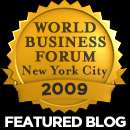Apr21
Andrea Meyer
Point: Companies can encourage innovation through employee contests
Story: The previous post on Harrah’s Entertainment generated some great discussion, particularly around EMC’s “innovation-by-contest” as one approach to generating innovations. Some companies (e.g., Harrah’s, HP) use themes to guide their employee-submitted innovations, and some companies (e.g., EMC) do not.  This prompted me to ask Wharton Professor Karl Ulrich, author of the forthcoming Innovation Tournaments (Harvard Business School Press, May 14, 2009) about his experiences with innovation contests. In his book, Ulrich uses the metaphor of a tournament to explore how ideas vie for attention and resources during the innovation process. Ulrich’s central metaphor is that companies use figurative or literal tournaments to progressively filter incoming ideas through a series of hurdles or gates during research, development, and new product introduction. At last week’s Silicon Flatirons‘ conference, I asked Karl about his view on the theme-based approach compared to the wide-open approach for an innovation contest. Ulrich recommended a wide-open approach for the first phase, saying that the wide-open approach might show clusters of idea suggestions on a new topic. He cited a cosmetics manufacturer with whom he’s worked. The cosmetics manufacturer’s contest got a numerous unexpected suggestions for foundations (make-up) for young people — an new area that the company decided to explore further. He added that many companies mistakenly try to fund too many projects — not narrowing the funnel fast enough.
This prompted me to ask Wharton Professor Karl Ulrich, author of the forthcoming Innovation Tournaments (Harvard Business School Press, May 14, 2009) about his experiences with innovation contests. In his book, Ulrich uses the metaphor of a tournament to explore how ideas vie for attention and resources during the innovation process. Ulrich’s central metaphor is that companies use figurative or literal tournaments to progressively filter incoming ideas through a series of hurdles or gates during research, development, and new product introduction. At last week’s Silicon Flatirons‘ conference, I asked Karl about his view on the theme-based approach compared to the wide-open approach for an innovation contest. Ulrich recommended a wide-open approach for the first phase, saying that the wide-open approach might show clusters of idea suggestions on a new topic. He cited a cosmetics manufacturer with whom he’s worked. The cosmetics manufacturer’s contest got a numerous unexpected suggestions for foundations (make-up) for young people — an new area that the company decided to explore further. He added that many companies mistakenly try to fund too many projects — not narrowing the funnel fast enough.
Action:
- Leverage employees’ knowledge of markets or technologies to spawn unexpected revolutionary or evolutionary innovations (e.g., EMC’s contest)
- Cluster the wide-open ideas by similarity, to create or modify themes or spot unexpected opportunities
- Use employees’ distributed knowledge to help focus attention on the best ideas (e.g., Harrah’s voting portal)
Case study, How-to, Innovation, Strategy
Apr15
Andrea Meyer
Point: Define priority innovation areas to harness employee energy
Story: When it comes to innovation, Harrah’s Entertainment doesn’t play games. The operator of a global chain of 50 casinos is pursuing a theme-focused innovation strategy similar to technology giant Hewlett-Packard and venture capital firm The Foundry Group. The company identified six areas of interest (akin to HP’s 8 themes and Foundry’s 5 themes – see Innovation Investment Strategy). Harrah’s target areas are: enabling technologies (such as wireless and radio frequency identification); enabling platforms (cloud computing, service-oriented architecture, anything-as-a-service); “smart” service (self-service kiosks); interactive CRM; next-generation gaming; and expanded channels to reach customers.
An innovation team of about 10 people from IT, marketing, customer service and gaming evaluate idea submissions from employees. Harrah’s also taps the innovations of vendors and is considering enlisting the public in seeking new innovations in gaming and entertainment. To gather even more feedback, Harrah’s created an “Innovation Portal” where employees can vote for their favorite innovation. Top management (CEO Gary Loveman and VP of Innovation Chris Chang) then decides which ideas ultimately get funded.
Action:
- Identify the areas of top priority to your firm, to help steer energy & momentum in the areas that will provide most value to your firm.
- Use themes to look for the deeper, long-term enablers and platforms rather than shallow short-term gadgets and projects.
- Ask employees for suggestions, feedback or votes on ideas within these areas
- Consider involving vendors, customers and the public as well, to expand the pool of ideas. (This strategy will require thinking through the IP issues.)
For more information on Harrah’s: Network Computing article
Case study, Customers, How-to, Innovation, New Product Development, Strategy
Apr13
Andrea Meyer
Point: How you get a product to market may be as important as what you get to market.
Story: The previous post looked at product systems innovation to build a new car. Going a step further: some companies expand the systems thinking to include distribution and service. Consider Tata Motors, which created the world’s cheapest car, the Tata Nano. To reach a retail price of $2,000, Tata focused on the costs of every system of car, including the system for distributing and selling the car. To keep costs low, Tata created a modular design and an innovative distribution model. Tata will manufacture modules centrally and, in some cases, ship the cars as kits to local entrepreneurs who will assemble & sell them. Tata designed to the modules to be glued together rather than welded because gluing is less expensive and doesn’t require costly welding equipment. Tata will also train the entrepreneurs to do servicing.
Similarly, Hindustan Unilever pioneered a distribution model in 2001 to get its personal care products into the hands of rural villagers. A significant fraction of rural villages lack paved roads, making traditional truck-based distribution very difficult. The company developed a network of 14,000 women and women-owned co-ops to serve 50,000 villages. The women handle the logistics and door-to-door retailing of a range of personal care products. To address the needs of the market and the novel distribution system, Hindustan Unilever changed product packaging. By using this approach, Hindustan Unilever does not have to deal with the problem of moving product in rural India. The women or their employees come to the company’s urban distribution centers to get the product.
Action:
* When designing new products or services, consider how those products will be distributed.
* Think about the role that local entrepreneurs or business partners can serve
* Design the product to support the distribution channel (e.g., modularity, ease of assembly, packaging, etc.)
For more information: Vijay Govindarajan discussed Tata Motors’ strategy at the HSM webinar on March 18 and will be speaking at the World Innovation Forum being held May 5-6, 2009 in New York City
Hindustan Unilever’s distribution model: Discussed at MIT Center for Transportation and Logistics Roundtable on Supply Chain Strategies in Emerging Markets led by Dr. Edgar Blanco.
Case study, Entrepreneurs, Growth, How-to, Innovation, New Product Development, Opportunity, Strategy
 This prompted me to ask Wharton Professor Karl Ulrich, author of the forthcoming Innovation Tournaments (Harvard Business School Press, May 14, 2009) about his experiences with innovation contests. In his book, Ulrich uses the metaphor of a tournament to explore how ideas vie for attention and resources during the innovation process. Ulrich’s central metaphor is that companies use figurative or literal tournaments to progressively filter incoming ideas through a series of hurdles or gates during research, development, and new product introduction. At last week’s Silicon Flatirons‘ conference, I asked Karl about his view on the theme-based approach compared to the wide-open approach for an innovation contest. Ulrich recommended a wide-open approach for the first phase, saying that the wide-open approach might show clusters of idea suggestions on a new topic. He cited a cosmetics manufacturer with whom he’s worked. The cosmetics manufacturer’s contest got a numerous unexpected suggestions for foundations (make-up) for young people — an new area that the company decided to explore further. He added that many companies mistakenly try to fund too many projects — not narrowing the funnel fast enough.
This prompted me to ask Wharton Professor Karl Ulrich, author of the forthcoming Innovation Tournaments (Harvard Business School Press, May 14, 2009) about his experiences with innovation contests. In his book, Ulrich uses the metaphor of a tournament to explore how ideas vie for attention and resources during the innovation process. Ulrich’s central metaphor is that companies use figurative or literal tournaments to progressively filter incoming ideas through a series of hurdles or gates during research, development, and new product introduction. At last week’s Silicon Flatirons‘ conference, I asked Karl about his view on the theme-based approach compared to the wide-open approach for an innovation contest. Ulrich recommended a wide-open approach for the first phase, saying that the wide-open approach might show clusters of idea suggestions on a new topic. He cited a cosmetics manufacturer with whom he’s worked. The cosmetics manufacturer’s contest got a numerous unexpected suggestions for foundations (make-up) for young people — an new area that the company decided to explore further. He added that many companies mistakenly try to fund too many projects — not narrowing the funnel fast enough.








